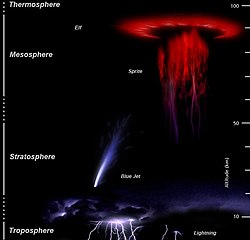Atmosphere-Space Interactions Monitor

Atmosphere-Space Interactions Monitor (ASIM) is a project led by the European Space Agency to place cameras and X-ray/γ-ray detectors on the International Space Station to observe the upper atmosphere in order to study sprites, jets and elves and terrestrial gamma-ray flashes in connection with thunderstorms.[1] It is hoped that measurements of these phenomena from space will contribute to the understanding of Earth's upper atmosphere.[2]
The ASIM components, originally planned to be completed in 2014, were launched on 2 April 2018 and mounted on the Columbus External Payload Facility on 13 April 2018.[3] Danish tech company Terma A/S is running the technical part of the project for ESA[4][5] and DTU Space (National Space Institute) from the Technical University of Denmark provides the scientific leadership of the project.[6] Mission operations will be performed by the Belgian User Support and Operations Centre (B.USOC) in Uccle, Belgium.[7][8]
First results from the measurements revealed that gamma ray bursts form when powerful electric fields course through the atmosphere, just before a lightning bolt travels along the same path. These results were published in July 2019.[9]
Instruments
[edit]The ASIM payload has a mass of 314 kg (692 lb) and consists of sub-systems CEPA and DHPU, and two scientific instruments called MXGS and MMIA:[3][7]
- The Columbus External Payload Adapter (CEPA) and Data Handling and Power Unit (DHPU) form the structural and electrical connections, respectively, to the Columbus module.
- The Modular X and Gamma Ray Instrument (MXGS) is a pair of terrestrial gamma-ray flash (TGF) detectors. The low-energy detector is sensitive from 15 keV to 400 keV, and the high-energy detector is sensitive from 200 keV to 40 MeV.
- The Modular Multi-Imaging Assembly (MMIA) is an optical imaging system capable of observing 12 frames per second continuously in the 777.4 nm and 337 nm bands at 5 nm wide intervals.
See also
[edit]- European contribution to the International Space Station
- Scientific research on the International Space Station
- Spacecraft Atmosphere Monitor
References
[edit]- ^ "ISS Utilization: ASIM (Atmosphere-Space Interactions Monitor)". eoPortal. European Space Agency. Retrieved 8 April 2018.
- ^ Neubert, T.; et al. (2006). The Atmosphere-Space Interactions Monitor (ASIM) for the International Space Station (PDF). International Living With a Star Workshop. 19-24 February 2006. Goa, India. Bibcode:2006ilws.conf..448N.
- ^ a b Halton, Mary (7 April 2018). "Hunting mystery giant lightning from space". BBC News. Retrieved 7 April 2018.
- ^ "Terma to Head ASIM Observatory for ISS". Space Travel. 27 August 2010. Retrieved 7 April 2018.
- ^ "Largest Space Project for Terma". Terma A/S. 26 September 2016. Archived from the original on 26 March 2018. Retrieved 7 April 2018.
- ^ Neubert, Torsten (2 February 2015). "ASIM: Climate and giant lightning discharges to be studied from the International Space Station". DTU Space. Archived from the original on 24 October 2015.
- ^ a b "ASIM Payload". ASIM.dk. Retrieved 7 April 2018.
- ^ "B.USOC role in the ASIM operations on the ISS". Belgian User Support and Operations Centre. 30 June 2014. Archived from the original on 9 April 2018. Retrieved 7 April 2018.
- ^ "Space station re-entry, Moon tapes and Ebola emergency". Nature. 571 (7766): 452–453. 24 July 2019. Bibcode:2019Natur.571..452.. doi:10.1038/d41586-019-02240-0. PMID 31341316.
External links
[edit]- ASIM.dk
- ASIM webpage at the European Space Agency's Human Spaceflight Research portal
- ASIM webpage by Terma A/S
- ASIM webpage at NASA's Space Station Research & Technology portal
